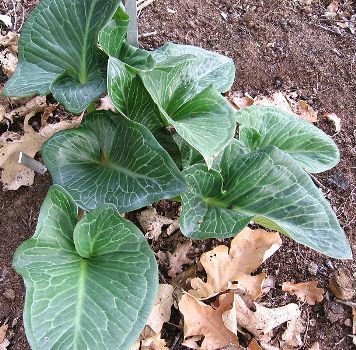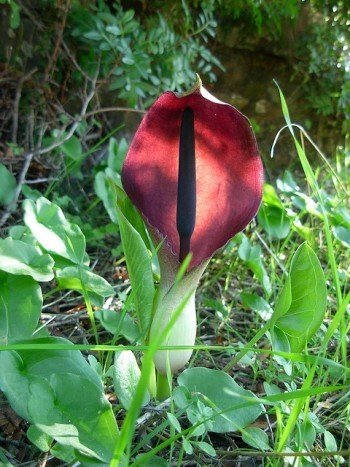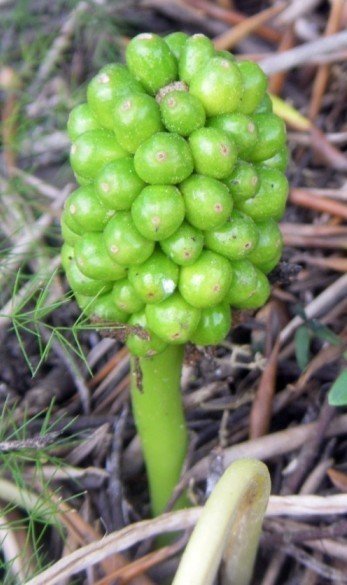





Arums are mysterious plants. You know the type: they send up intriguing foliage in one season, perhaps an unusual flower in another season, and then, long after you've forgotten about the plant altogether, it pops up with an unusual fruit or seed head. Arum pictum, unlike other members of the arum family, makes a dramatic appearance in the autumn, just when you least expect to see it!
In my area of central Illinois, the most common arum is Arum italicum, and it is a spring woodland flower. I rarely notice it in the flowering stage, though the blooms are attractive. Rather, it is the dramatic red seed heads that appear later in the summer and fall that catch my eye! I've already had two friends present me with the red clustered seeds for identification, one in person, and one by e-mail! I initially was confused, when I began researching arum pictum, as there is actually a variety of Arum italicum that bears the name 'Pictum.' You can find a PlantFiles entry for this plant, fascinating in its own right, here. You may be more familiar with some other members of the aroid family, such as peace lilies, calla lilies, and the wildflower known as Jack-in-the-Pulpit. They all feature flowers formed of a spathe with a central spadix.
 The focus of this article, however, is a separate and distinct plant, Arum pictum, which shares the common name Lords and Ladies with several other species in the Arum family. This brazen individual is known for producing its dramatic purplish-black blooms in the autumn, when blossoms in the woodlands are much less common. It is native to the Mediterranean region, particularly in the coastal regions. It can be grown successfully in the warmer zones of the United States, possibly starting at the southern end of zone 7, and more easily thriving in the warmer zones. In researching this article, I was privileged to correspond with C.J. Addington, an educator in northern California, who grows Arum pictum in naturalized clumps in his garden. I owe him thanks for permission to use his picture at the start of this article!
The focus of this article, however, is a separate and distinct plant, Arum pictum, which shares the common name Lords and Ladies with several other species in the Arum family. This brazen individual is known for producing its dramatic purplish-black blooms in the autumn, when blossoms in the woodlands are much less common. It is native to the Mediterranean region, particularly in the coastal regions. It can be grown successfully in the warmer zones of the United States, possibly starting at the southern end of zone 7, and more easily thriving in the warmer zones. In researching this article, I was privileged to correspond with C.J. Addington, an educator in northern California, who grows Arum pictum in naturalized clumps in his garden. I owe him thanks for permission to use his picture at the start of this article!
Arum pictum is a very visually attractive plant, even in the seasons prior to bloom. It is very low-growing, reaching roughly 8 to 12 inches in height, and it produces glossy, heavily veined leaves in late summer. The leaves are roughly heart-shaped, rising on short stems from a central point on the tuber.
A gardener who chooses it for its lovely foliage may receive a double shock a few weeks later when fall rolls around. The first surprise is visual, when the gardener finds a flower rising from the leaves, made up of a cup-shaped spathe, greenish on the exterior at the base and deepening to burgundy or darkest purple toward the tip, and evenly dark purple within. Rising from the center of the spath is an even darker central spadix. The second, less pleasant surprise is olfactory in nature, due to the odor that emanates from it. I have heard it most often compared to the smell of horse dung, though comparisons to skunk roadkill and rotting flesh are common, too.
later when fall rolls around. The first surprise is visual, when the gardener finds a flower rising from the leaves, made up of a cup-shaped spathe, greenish on the exterior at the base and deepening to burgundy or darkest purple toward the tip, and evenly dark purple within. Rising from the center of the spath is an even darker central spadix. The second, less pleasant surprise is olfactory in nature, due to the odor that emanates from it. I have heard it most often compared to the smell of horse dung, though comparisons to skunk roadkill and rotting flesh are common, too. The leaves persist throughout the winter, after the flower has faded. The seed head, very striking in its own right, appears later the following summer, after the leaves have died back. It appears as a central stem with a cluster of tightly grouped seed-bearing berries, which are initially bright green, and ripen to a vibrant orange-red.
The leaves persist throughout the winter, after the flower has faded. The seed head, very striking in its own right, appears later the following summer, after the leaves have died back. It appears as a central stem with a cluster of tightly grouped seed-bearing berries, which are initially bright green, and ripen to a vibrant orange-red.
As a coastal and woodland plant, it grows well in partly sunny to sunny areas, and likes rich, well-drained humus-y soil. It can be grown in a pot, which is clearly a necessity if you live in a zone that experiences frost and extended periods of cold. I wouldn't necessarily welcome this plant into my home, due to its distinctive (ahem) fragrance, but it might be an interesting specimen to visit in a well-ventilated greenhouse setting.
Just a note of warning: most members of the arum family are poisonous. They can sicken pets and other animals that nibble on them, and can even cause skin irritation when unsuspecting explorers touch the foliage, blooms, and clustered berries on the seed heads.
My thanks to the following photographers, who either gave personal permission to use their photos, or (where indicated) made them available for use. Please respect their copyrights, and do not use these images without their express permission.
Thumbnail of potted Arum pictum at start of article: C. J. Addington, originally found on Flickr, and used with express permission.
Foliage picture: submitted for common use to Wikimedia Creative Commons by Digigalos
Image of blooming arum pictum in Sardinia, Italy, by Matteo Paolo Tauriello, available through Flickr (some rights reserved)
Image of Arum pictum berries, by Isidro Martínez (DG member Zaragoza) who also kindly submitted it to PlantFiles. We struck up a correspondence about some pictures he had submitted, and I was pleased to learn that he was also a member of Dave's Garden. I love how Dave's Garden makes the whole world seem within our reach!
The best trees for a cactus and succulent garden
Blooms for the Florida Fall and Winter Garden: Not Just Orange, Yellow and Red
Flowering House Plants for the Home and Office
Plant Black Cherry Trees for the Birds and Bees
10 Plants for Colorful Fall Blooms in the Drought-Tolerant Garden
12 Cool DIY Planters for the Garden and the Home
Installing The Variety Garden Fencing Panels For Beauty And Landscaping Of Garden
Grow Backyard Garden In The Fall
Fiberglass Plant Planters ?Bringing Elegance and Functionality to the Indoor Garden
Choosing the Right Plants and Color Combinations for Your Garden
Garden Pest Control - The Secret of Caring For the Garden and Lawn
Copyright © www.100flowers.win Botanic Garden All Rights Reserved